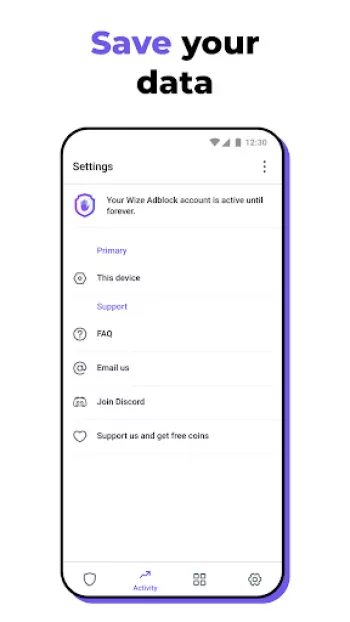Apps Home

Understanding Safe and Fast Browsing
Safe and fast browsing is no longer a luxury but a necessity in our digital age. With the myriad of content available online, the need for protective measures is paramount to prevent encountering malicious content or wasting bandwidth on unnecessary ads. The essence of safe and fast browsing lies in employing technology that not only mitigates risks but also enhances user experience by optimizing data flow and quickening website accessibility. The technology behind this involves advanced DNS (Domain Name System) services like Wize DNS, which identifies harmful traffic and responds appropriately to protect your device. By forwarding DNS requests that appear suspicious to specialized DNS servers, it helps filter internet traffic, essentially acting as a guard against potential threats. This method ensures users are not only traversing the internet with greater security but are doing so at an optimized speed, thus achieving a more efficient browsing experience. Additionally, breaking down the components, safe browsing necessitates blocking ads that can be vectors for malware or phishing attacks. Through ad blockers and tracker blockers, it's possible to eliminate these nuisances. These blockers work by identifying ad content via DNS filtering—flagging and blocking requests associated with advertising and tracking networks before they reach your device. Safe browsing is further enhanced by providing cues to users about potential threats, such as notifying them about malware, phishing attempts, or unsafe websites. This involves real-time analysis of the web pages visited and a database of known threats, ensuring continuous protection. Fast browsing, on the other hand, is facilitated by reducing the amount of unwanted data transmitted. By blocking ads and pop-ups, the browsing process is streamlined. Ads often contain large graphics or videos that slow down website loading times, and pop-ups interrupt user interface and navigation. Eliminating these elements leads to reduced bandwidth usage and quicker load times. The amalgamation of a streamlined visual experience without clutter and enhanced security features truly defines the ideal of safe and fast browsing, representing a significant step forward in digital navigation.
The Technology Behind Ad Blockers and Trackers
The burgeoning need to block advertisements and trackers has led to advancements in how this is technologically implemented. Ad blockers like Wize AdShield employ several methods to detect and block unwanted content effectively. Primarily, the core technology relies on filtering and DNS-based blocking strategies. DNS filtering is a technique where DNS requests associated with advertising and tracking networks are intercepted and blocked. This approach is non-intrusive and requires no additional download of website elements, thereby enhancing the speed at which content loads. By adopting such an ad-blocking strategy, these intelligent systems can preemptively prevent ad content from being downloaded, sparing users from intrusive experiences and potential threats hidden within ads. Moreover, DNS-based strategies also capture and block malicious domains known for fraudulent activities. This means that even if a user unintentionally lands on a malicious site, the DNS server can intercept those attempts, ensuring that harmful transactions are thwarted. In addition to DNS filtering, script blocking is another method used by ad blockers. This entails preventing JavaScript code from running, which is commonly used in ads and trackers. By disabling these scripts before they execute, users can avoid the loading of intrusive elements that are not only disruptive but can also present security risks. Furthermore, these blockers often rely on extensive databases with lists of known ad-serving domains and trackers. These lists are dynamically updated, ensuring that as the internet evolves and advertisers find new ways to push content, the blockers are capable of shielding users effectively. Users can usually choose to customize their blocker settings to determine the level of blocking they wish to engage—whether a complete shutdown of all advertisements or selective filtering based on type or source. Ultimately, whether through DNS filtering, script blocking, or database management, the underpinning technology of ad blockers and trackers is a sophisticated blend aimed at providing seamless yet robust protection and an uncompromised browsing experience.
Privacy and Security in Online Browsing
Privacy and security are crucial components of the online experience that demand constant attention in the rapidly changing landscape of digital information. Privacy aspects go beyond the simple notion of anonymity and encrypting data to involve a comprehensive approach to personal information management and control. At the heart of achieving privacy while browsing is the capacity to manage and minimize data footprints. Ad blockers like Wize AdShield play a pivotal role in this by not only blocking ads but also preventing the trackers used by advertisers to follow users across the web. These trackers aim to create detailed profiles of user activities to target them with personalized ads, thereby infringing on personal privacy. By stopping these trackers at the DNS level, Wize AdShield helps users maintain their anonymity, ensuring their browsing behavior remains private. Moreover, secure browsing is fortified through the use of features that warn users of potential security threats such as phishing sites or those laced with malware. By leveraging extensive threat databases that are regularly updated with new information arising from the darker corners of the internet, these systems can offer real-time protection. Privacy also includes measures like end-to-end encryption for data transmitted to and from browsers, ensuring that sensitive information is safeguarded against interception. Implementing HTTPS protocols adds another layer of security, maintaining data integrity and confidentiality. In terms of user empowerment, browsers and extension tools offer settings to control the permissions granted to websites. This can include access to location, camera, microphone, and more, allowing users to decide what information they wish to share and with whom. Adopting a privacy-friendly browser can further enhance this experience with built-in privacy safeguards. Thus, the amalgamation of tools and practices centered on ad blocking, tracker prevention, encrypted communications, and controlled access echoes a robust commitment to maintaining privacy and security in online environments, negating the intrusive nature of modern web applications.
Aesthetic and Functional Improvements in Browsing Experience
The browsing experience has undergone significant transformations over recent years, largely due to enhancements brought about through technologies like ad blockers and refined user interface designs. Aesthetic improvements consist of creating uncluttered and intuitive interfaces. Ad blockers are instrumental in this endeavor, as removing intrusive advertising elements such as pop-ups, banner ads, and video advertisements, leads to cleaner, distraction-free webpages. This facilitates a smooth and immersive experience for users, allowing them to focus on the content itself rather than disruptive elements. Beyond aesthetics, functional improvements are equally important and are driven by technologies like DNS filtering and caching mechanisms employed by tools such as Wize AdShield. These technologies ensure websites load more rapidly by reducing server requests and managing data efficiently. Functional optimization is also rooted in aspects like adaptive design, ensuring that webpages appear consistently across different devices and screen sizes. Tools including ad blockers enable better adaptability by managing how content is delivered, preventing inconsistencies that arise from ad-heavy elements that may not be supported on all devices. Moreover, increased functionality extends into aspects of accessibility. By curating the kind of content loaded on a page, ad blockers contribute to easier and quicker navigation, aiding those who rely on accessibility features like screen readers. Additionally, minimizing the data overhead associated with high-volume advertisements allows for faster interactions which are beneficial for both users and content providers by improving user retention and engagement rates. Collectively, these advancements signify a harmonious blend of aesthetic allure and functional proficiency in modern browsing, underpinning a seamless interaction where technology aids in focusing on quality content rather than detractors.
The Pathway to Secure and Ad-Free Browsing
The pursuit of secure and ad-free browsing is pivotal as the digital world continues to evolve, bringing forth a pathway forged by innovation and regulatory evolution. The ongoing development of tools like Wize AdShield signifies a critical movement towards enhancing user autonomy online. An ad-free environment is made possible through sophisticated DNS technology which continually adapts to new advertisement techniques, ensuring dynamic and agile protection that is crucial as advertisers invent new ways to circumvent traditional blockers. Security is maintained through layered approaches, combining real-time threat detection with comprehensive databases of malicious entities to preemptively block potential attacks. This pathway is enriched by implementing a decentralized approach towards privacy, granting users control over which requests are forwarded to protective DNS servers like Wize DNS. Users thereby become gatekeepers of their information flow, achieving a tailored browsing experience according to individual needs. Moving forward, regulations such as GDPR (General Data Protection Regulation) establish a legal framework encouraging transparency and user empowerment regarding personal data usage. This regulatory environment supports technologies purposed at maintaining privacy, aligning with the efforts of ad blockers designed to eradicate unnecessary data collection practices. The convergence of innovation, user empowerment, and regulatory vigilance fosters a browsing ecosystem that is both secure and respectful of personal boundaries. As we harness these tools, users are encouraged to embrace an informed perspective on browsing, understanding the best practices for security and privacy, utilizing encryption tools, and remaining vigilant against emerging threats. As the path to browsing that is both secure and devoid of distraction unfolds, users should equip themselves with wisdom on utilizing available resources efficiently, ensuring they enjoy an optimized online experience. To initiate or continue this transition to a secure, streamlined way of browsing the web, empower yourself today with tools available on various platforms, including Download for Android, Download for iPhone, Download for Windows, Download for Linux, and Download for Mac.
Share Your Opinion
Your Email Will Not Be Published.
All Rights Reserved © Apps Home 2025







































Sarah Sumpter
Free and easy to use! Greatly reduced the amount of ads I saw! Doesn't work on YouTube but Google has been cracking down on things like that and ha...
RL Technician
This might be the best ad blocker ever. It might not block youtube ads, but that's okay when I could use other web browsers that block ads. It bloc...
CJ
This actually does work on the few I've test. One still showed ads but not the popup or annoying ones. Just flat images. I used it to block intrusi...
Jace Mccray
It's been great, honestly. the only complaint i have now is that it suddenly stopped blocking ads of an app. But I think that's just due to an upda...
Kody Strecker
Really this application should be five out of five stars, but I'm gonna say a few minor problems that keep it from getting 5 stars. 1. Notification...